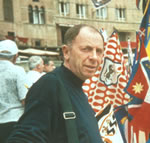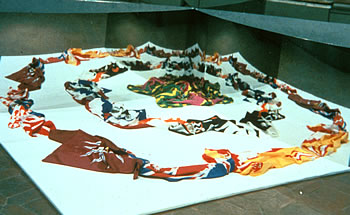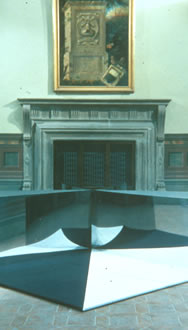 |
 For an equestrian outlook
For an equestrian outlook
"At that time I used to think that art was the height of the human
expression, the best of human intelligence.". This is what Getulio
Alviani wrote at the beginning of the 1960’s. Art has always solved
problems. To defend their city from a terrible siege, the ancient inhabitants
of Florence summoned Michelangelo. Today, on the contrary, the artist
seems to have renounced the role of a resolver and of inventor of new
technologies. Quoting another statement of Alviani, "nobody would
dream of summoning an artist to the NASA and ask his/her opinion regarding
technical-scientific issues". The artist shouldn’t just be using
the telephone: he should have invented it. When once then the principle
was science, today - and exactly as rigorously - it is the language. Quadrato
(rosa) e suo doppio (triplo) ("(Pink) square and its double (triple)")
can be arranged on two walls, one element facing the other. The element
placed in a specular position is the square’s double and the pink’s
triple at the same time. Once Alviani used to build machines which didn’t
exist in real life; now, he has mantained that same striving towards a
sculptural quality in his works. And an outstanding execution. Riflessione
trasparente ("See-through reflection" - the title hints at the
mental reflection as well) consists of two elements one of which fits
into the other: one is a curved mirror, the other one is a metal bar piercing
through it. The bar is formed by two parts made of two different iron
alloys: steel (which doesn’t rust) and corten (the part which will
undergo the metamorphosis caused by rust). We can see here a spur of the
interest that the artists of the typically Italian currents of "kinevisual
art" and of "programmed art" once showed for the different
nature and function of materials. The reflection in the mirror looks like
transparency, while in reality the iron element is multiplied. There is
a continuity instead of two opposite polarities. Alviani’s work is
always based upon basic elements like the circle or the square: the first
one has no boundaries, while the second one has always a limit. The works,
simple and essential in the purity of its shape, is constructed according
to a series of antithesis.
The work presented by Getulio Alviani in the Sala of Palazzo Patrizi in
Siena is close to those formal principles and it is dedicated to the most
important event in the city: the Palio (in that same room, Giulio Paolini
had already held an exhibition which was organized by Luciano Pistoi and
dedicated to the Palio). Alviani is not interested in the competition,
nor in what happens to the horses or to the jockeys, nor in the historical
tradition of the city; as an artist whose research is centered upon the
visual aspects of art, he is rather interested in the visual apparatus
surrounding the event, that is, in all the emblematic equipment of the
city: flags, marbles, scarves, cockades, coats of arms bearing the colors
of the various "contrade" ("city quarters"), etc.;
all of them are apt to create thousands of plays on images. The bases
are formed by three square caissons measuring 180 x 180 x 60 cm; one is
white, one is black, and the third one is black and white, reminding of
the colors of the city’s coat of arms (a wolf on a black-and-white
background).On each base there are two curved elements made in reflecting
steel, which are joined at one end and reflect all the things that are
placed in front of them, multipling their image. This work is derived
from another one, made by Alviani in 1964: It was called Opgame and it
was a... game ("... an optical game which was maybe serious, too...
just like the Palio..." so writes the artist now) composed by green
and pink disks which looked as if they were multiplied due to reflection.
In this case, though, the word "Palio" is repeated, too: it
is taken into consideration for the visual impact of the letters and so
the work’s title is opaliop ", with manyfold ... optical meanings
which are ‘equestrian’, too", as the artist himself writes.
The playing on words, then, reminds of the title of the 1964 work and
of a purely optical effect, as well as of the horses that can be considered
as the visual elements of the competition and that are traditionally incited
with the words "op, op, jump you little horse!". One more reference
hinted at by the complex title is constituted by the wings of the two
steel elements. Finally, the title itself is made by use of the same reflecting
phenomenon upon which the whole work is based. 
Maurizio Fagiolo has recognized as the distinctive features of Alviani’s
work two elements which are always found intermingled within the artistic
tradition, from the baroque to the futurism, that is, light and dynamism.
"Dynamism is also true for other activities. The op dresses, for
instance, which are designs for high-fashion dresses (created for Marucelli)
in which the motif is combined with the pleated fabric, so that the two
create a unity (and today we can witness an "op"-fashion). The
op studies, realized by means of lines woven at right angles to create
tiny meshes in varying sizes, or in which the lines are circular or spiral-like
and look like targets or hypnotic motifs. The op games which have specular
curved elements that reflect objects to the point that these are multiplied
as if in a "fair of vanity". The op structures, where a single
module is repeated by means of colors, too, so that facets are cut upon
the programmed diamond. Last but not least, the op architectures, the
first example of which is the "surface with vibratile texture"
devised for the Kindergarten in Leverkusen. So this is the ultimate purpose
of these structures: just like Enzo Mari, Getulio aims at the urbanistic
outlines, at the modulation of buildings, at the world of life" (1).
The op game is then inserted into a more general discussion which is based
upon a whole generation’s tension, that is, the urge to re-build
the world.
Furthermore, seeing as Alviani’s work is all based upon the assumption
that there is a relationship between art and science, and that this implies
exactness, a distinctive feature is also ‘consequence’. Therefore,
some observations that were made at that time are still valid: "Giving
up alien means, Alviani reaches a new form of illusionism (are the surfaces
flat or ondulated?). He does not present a complete, perfect image; rather,
he suggests a value to be conquered, to be gained. It is not a point of
view, but the search for a point of view and the latter, useless to say,
will never be found. Alviani’s object changes physically and surpasses
the onlooker: it represents a concrete and physical phenomenon while it
remains always "beyond". " In this work centered on the
Palio the point of view is changeable, too, and the illusionism is remarkable:
in fact, the object can’t quite be distinguished from its reflection.
The onlooker’s dynamism plays an important part in the appreciation
of the work. "Alviani says the same things, even though in different
ways: he’s interested in didactics, in the visual education, in the
pattern of behavior. One of his structures contains a number of other
ones: there is no outlook prevailing upon the others, for all possibilities
are acceptable." There is therefore no privileged standpoint, and
the research is difficult because it takes into consideration all the
different possibilities. Also, "light reveals itself as one and many".
The technical aspect which enables to verify the different opportunities
is here fundamental. "Alviani has developed a formula for the dynamism
of his works, which is as infallible as a logical-mathematical demonstration:
specularity + reflection + source of light + visual angle + movement =
vibravibratile quality (of the object) + behavior + interrelationship
+ perception = situation" The situation, that’s the problem,
and the arrival point is dual: the work is in a "situation"
and the onlooker is in a "situation". So opaliop reflects the
multiform situation of the Palio.Notes
1) This remarks by Maurizio Fagiolo, as well as the following ones, are
excerpted from the essay L’iperluce di Alviani as published in M.
Fagiolo dell’Arco’s Rapporto 60. Le arti oggi in Italia, Bulzoni,
Roma 1966. Alviani realized the cover and the title-page of this book..
|
 |


